
Over the past decade, data communication rates have increased by a factor well over 10x. Data rates that were once 1 Gbps and below are now routinely greater than 10 Gbps. Optical communication is now routinely being designed at 100 Gbps and above, with research targeting 1 Tbps in the near future.
RF wireless communications now employ broadband signals in the 20+ GHz range, and at the same time both RF and optical communications utilise complex modulation schemes and low amplitude signals to meet channel data capacity and regulatory requirements.
This has driven the need for very high bandwidth real-time oscilloscopes for the validation, certification and debugging of these new system designs. As a result, oscilloscope designers are driven to extend the performance of real-time oscilloscopes to cover requirements up into the 60 GHz–70 GHz range and beyond.
This article compares the techniques used to extend the bandwidth performance of real-time scopes, and introduces the latest innovation in this pursuit – asynchronous time interleaving.
The conventional ADC channel
The conventional real-time digital oscilloscope channel typically employs an analog front-end, which normally consists of a preamp and/or attenuation for signal conditioning, and a track-and-hold for locking the signal amplitude during the sampling period. An analog-to-digital converter (ADC) is used to convert the sequential voltage levels coming from the track-and-hold to a stream of numeric values.
Providing that the analog front-end supports the full bandwidth requirements of the channel, the sample rate of the ADC becomes the primary constraint to the bandwidth of the channel. The Nyquist Theorem states that in order to reproduce an accurate representation of all signal content within the desired bandwidth, the sample rate must be more than two times that bandwidth. For example, a 25 GHz channel bandwidth will require greater than 50 GSps sample rate. As the bandwidth requirements continue to increase, finding ADCs that meet the Nyquist requirement becomes a bigger challenge.
It is appropriate at this point to consider channel noise for the conventional ADC channel, as this will become the foundation for further comments regarding channel noise associated with the techniques described below for extending the ADC performance.
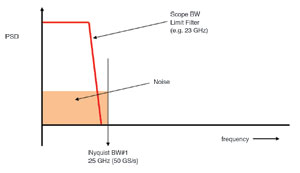
Figure 1 depicts the random noise power spectral density (PSD) relative to frequency. Because random noise by definition contains all frequencies, the PSD is spread equally across the Nyquist bandwidth of the instrument. In the case of a 50 GSps channel, the Nyquist bandwidth is 25 GHz.
There is some noise rejection that occurs in Figure 2 because the scope bandwidth (BW) limit filter (also called an anti-alias filter) rejects noise that exists in the spectral region between the cutoff of the BW limit filter and the Nyquist bandwidth of the channel.
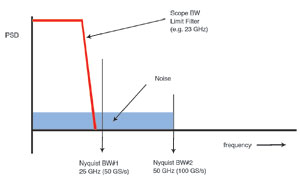
Time-interleaved channels
As soon as the bandwidth requirements extend beyond the sample rate capability of the available ADC components, it becomes necessary to find other techniques to utilise available components to meet those extended requirements, or design a new generation ADC.
Time interleaving is a common technique to extend the performance of existing components. Here, the analog front-end is designed to pass the entire bandwidth of interest, and two A/D converters are used in parallel. Each ADC must provide a sample rate at least half the total sample rate required to meet the Nyquist requirement. For example, provided that the analog front-end could support up to 45 GHz, two 50 GSps A/D converters could be interleaved (see Figure 3) to provide 100 GSps conversion.
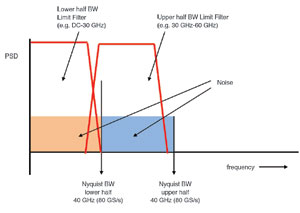
It is important to note that as sample rate increases, the random noise is spread evenly across the new Nyquist bandwidth. In the example shown in Figure 2, the sample rate is increased from 50 GSps to 100 GSps, so the Nyquist bandwidth is now extended from 25 GHz to 50 GHz.
If the noise performance of each of the time interleaved channels is equal, the noise power spectral density is now about half the power, spread evenly across the new Nyquist bandwidth.
Practical implementations of this approach have demonstrated noise reduction in the range of 15%–20%.
Frequency interleaved channels – mixing it up with down-converters
Down-converters have been used for well over a century in radio receivers and other RF applications. The concept is simple: mix two frequencies, and the result will be a sum and a difference in frequencies (also called heterodynes). If you can carefully select one of the two frequencies (e.g. a local oscillator) in relationship to the other, you have the ability to move the difference frequency to a more convenient range (typically lower) within which to work.
In the case of an oscilloscope channel, setting the local oscillator frequency to equal the mid-band of the analog front-end bandwidth allows the possibility to acquire the upper half of the scope passband with one ADC, and the lower half of the passband with another ADC. Reconstructing the total waveform by ‘stitching’ together the upper and lower spectral halves becomes a DSP task within today’s digital real-time oscilloscopes.
The key advantage for the oscilloscope designer is that each ADC needs only to have a sample rate that is greater than the total bandwidth. However, there are challenges in this design approach. Once the acquisition has completed, and the data is in waveform memory, it is necessary to up-convert the upper band back to its original frequency range using digital signal processing techniques (DSP).
Recovering the two spectral halves and reconstructing the waveform is complicated. Because the paths are not identical, it is necessary to compensate for these differences in the calibration that is part of the DSP.
Furthermore, due to the sharp cutoff of the bandpass filters used on the two spectral halves, recovering the exact centre of the spectrum is problematic. Issues have been seen with flatness at the recombination zone, as well as phase linearity shifts at that point.
Returning to the discussion of noise (Figure 3), it is informative to consider what happens to channel noise when using the frequency interleaving technique. As mentioned previously, the noise PSD is evenly spread across the Nyquist bandwidth (half the sample rate) of an acquisition channel. Because each ADC is acquiring half of the entire frequency span, there is no potential opportunity for noise reduction when going from time interleaved to frequency interleaved configurations (while keeping the bandwidth constant). In fact, there is generally a noise increase when using frequency interleaving.
Asynchronous time interleaving – a down-converter technique with a difference
In recognition of the technical issues and challenges involved with the architecture of the frequency interleaving that has been used to date in GHz bandwidth oscilloscopes, a new approach has been taken by Tektronix to avoid some of the disadvantages of DBI, while still accomplishing the end result of extended bandwidth with existing ADCs. With asynchronous time interleaving (ATI), a pre-sampler is used as a harmonic mixer.
One of the things that jumps out at first glance about this design is that the paths are symmetrical. There are no significant differences in propagation delay or phase shift between the two sides of the acquisition channel. This simplifies the post-acquisition process of DSP re-mixing or reconstruction as compared with DBI, minimising the amount of error at the mid-band crossover.
With ATI, the entire bandwidth of the signal is applied to both ADCs. In this way, the power spectral density of the noise is evenly spread across the total sample rate, which is 2x the sample rate of the individual ADCs. The result is that the overall noise in the passband is lower than it would be in the comparable DBI architecture.
Because harmonic mixing and time sampling are really the same thing, it is possible to accomplish the mixing. This design utilises the pre-sampler to intentionally sub-sample the input signal, thereby aliasing or folding back the upper half of the spectral content back into the Nyquist bandwidth of the ADC.
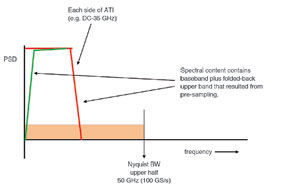
For example, a 70 GHz system could be achieved by running the asynchronous sample clock at 75 GHz. This would result in the upper half of the 70 GHz signal being aliased back into the range of DC to 37,5 GHz. The resulting data from the pre-sampler could then be sampled by the ADC at a rate independent from the pre-sampler, such as 100 GSps. Note that the pre-sampler is running asynchronously from the ADC sample clock. Figure 4 represents the signal on each leg of the ATI channel.
The output of the pre-sampler is a spectrum that contains a difference spectrum of the upper band folded back onto the lower band range, as well as the sum spectrum of the lower band overlaid on the upper band range. This complex spectrum is then passed through a low-pass filter that removes the upper band range, but passes the lower band (including the folded back upper band content) intact. This filtered signal is then passed to the track and hold, and captured by the ADC.
Once the acquisition is complete, and the data is stored into memory, the original signal can be recovered by re-mixing the signal digitally using DSP techniques. At this point, rather than a physical asynchronous sampling clock signal, a mathematical representation of that asynchronous sampling clock signal can be used as input to the digital mixer, taking care that the phase relationship between the original analog asynchronous sampling clock and the mathematical representation of that signal are identical.
Note that the two pre-samplers are 180 degrees out of phase; this is important when it comes to reconstruction of the signal. After the digital mixing step of signal reconstruction, the numerical signal contains the sum and difference spectral content from the original acquired data.
Conveniently, during the final combining of the signals, the portions of the spectrum that are 180 degrees out of phase cancel, and all that is left is the original spectrum, plus a portion of the sum spectrum which is removed with a 75 GHz low-pass filter. This leaves only the content from DC to 70 GHz that was originally applied to the scope for acquisition.
The final combining step is essentially a summation divided by two. This function returns the input amplitudes to their original value, but also has the effect of averaging the noise of the overall acquisition, thereby further reducing the total noise of the measurement channel.
First ATI implementation: DPO77002SX
Tektronix’ DPO77002SX 70 GHz ATI Performance Oscilloscope is the first production model incorporating ATI technology. It provides one channel at 70 GHz bandwidth, 200 GSps using ATI technology or two channels at 33 GHz bandwidth, 100 GSps using conventional real-time acquisition.
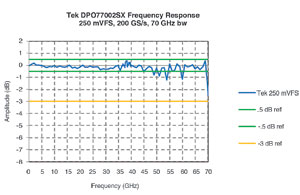
The frequency response of this new instrument demonstrates outstanding flatness out to 70 GHz. As shown in Figure 5, there are no significant dips or peaking in the mid-band region. This assures the most accurate amplitude measurements across the spectrum.
Regarding noise performance, ATI again provides outstanding performance. Figure 6 shows a comparison of noise performance between a standard 33 GHz channel and the ATI channel set to 33 GHz bandwidth, with both set to the same vertical scale. We see here that rather than being higher noise on the ATI channel, the ATI channel is actually 21% lower noise. This is a significant contrast from the frequency interleave channels discussed previously. The left side screen shows the standard channel with a baseline noise of 1,05 mV rms, while the right side screen shows the ATI channel with a baseline noise of 838 µV rms.
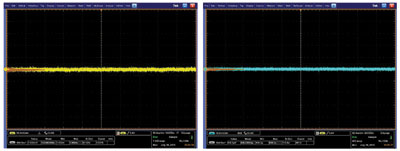
For more information contact Comtest, +27 (0)10 595 1821, sales@comtest.co.za, www.comtest.co.za
| Tel: | +27 10 595 1821 |
| Fax: | +27 11 608 1525 |
| Email: | sales@comtest.co.za |
| www: | www.comtest.co.za |
| Articles: | More information and articles about Comtest |
© Technews Publishing (Pty) Ltd | All Rights Reserved